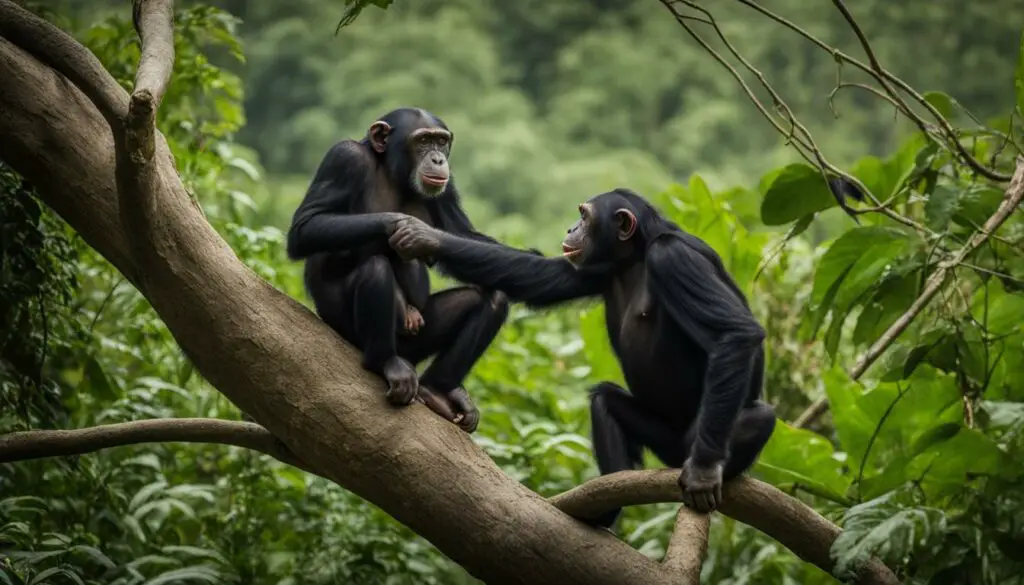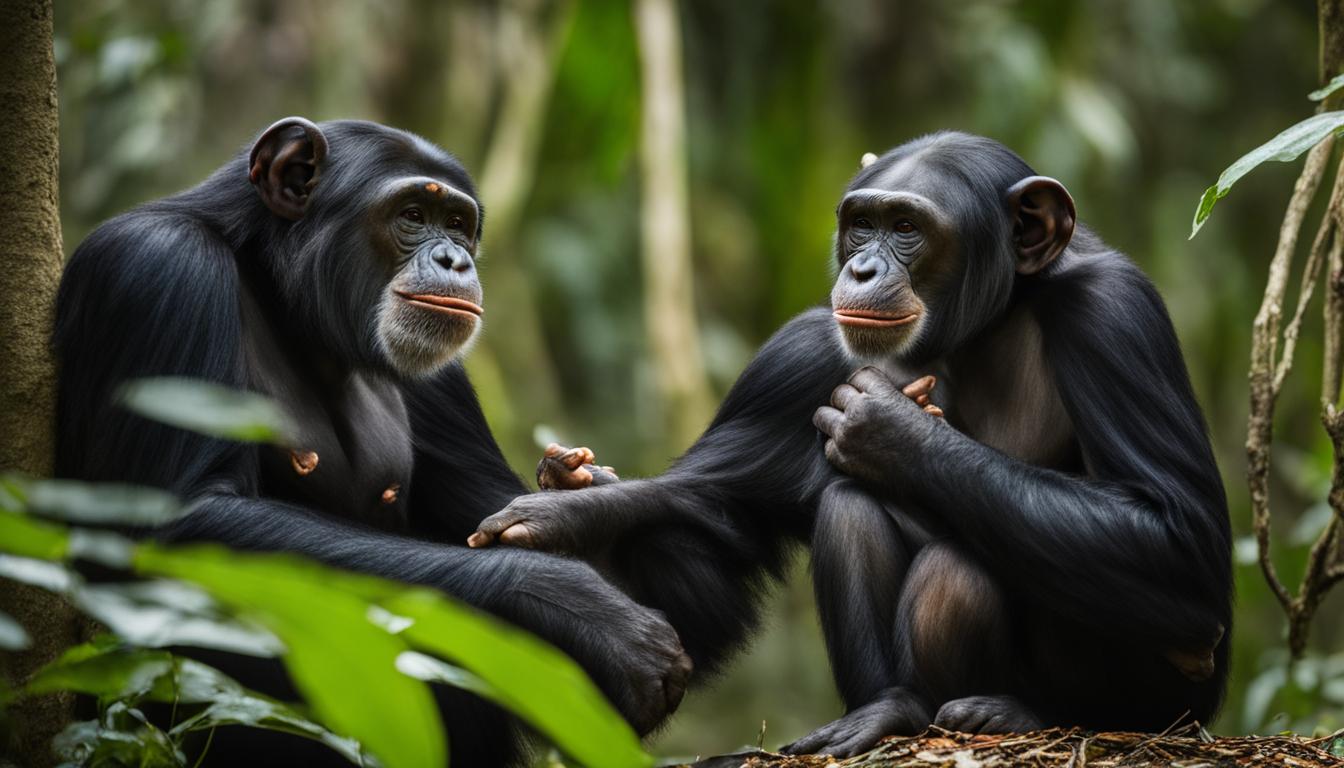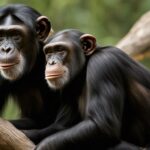If you’ve ever wondered about the fascinating mating habits, reproduction, and breeding behavior of chimpanzees, this article will provide you with all the information you need. Chimpanzees, as highly social animals, have unique strategies and behaviors when it comes to mating. From their courtship rituals to their intricate social structure, chimpanzees exhibit a variety of fascinating characteristics.
Year-round mating is observed among chimpanzees, with both males and females actively participating. Females display sexual signals through their pink and swollen genitals, while males exhibit their interest by displaying erect penises or shaking tree branches. The mating process itself is brief, typically lasting only 6 to 7 seconds.
It’s also important to note that mating is not exclusive to one male, as females have the freedom to mate with multiple males within the community. The dominant alpha male does not have complete control over mating, and subordinate males often engage in secret mating to avoid detection.
Chimpanzees have various strategies when it comes to mating, including polygamous and promiscuous behavior. Polyandry, where females mate with multiple males, and promiscuous behavior among males are observed. These strategies contribute to genetic diversity and reduce the risk of inbreeding within chimpanzee populations.
In addition to avoiding inbreeding, chimpanzees also engage in mate choice based on genetic compatibility. They have been observed to prefer mates that are genetically dissimilar to them, further ensuring genetic diversity.
Chimpanzees are intelligent creatures, known for their ability to use tools, cooperate, and exhibit complex social behaviors. Their intelligence likely plays a role in their mating strategies, such as forming social bonds for support and protection.
Unfortunately, the population of chimpanzees in the wild is critically endangered due to various threats. Conservation efforts are vital in protecting these incredible animals and ensuring their survival for future generations.
Stay tuned for the upcoming sections of this article, where we will delve deeper into chimpanzee mating strategies, inbreeding avoidance, courtship and reproductive behaviors, social structure and mating dynamics, and the impact of chimpanzee intelligence on their mating strategies.
Chimpanzee Mating Strategies
Primates, including chimpanzees, exhibit a range of mating strategies influenced by their social structures and reproductive needs. Understanding these strategies provides valuable insights into primate behavior and the diversity of animal mating habits.
Chimpanzees engage in both polygamous and promiscuous mating, allowing for genetic diversity within their populations and reducing the risk of inbreeding. Females in estrus, characterized by their pink and swollen genitals, may mate with multiple males within the community, a behavior known as polyandry. On the other hand, males seek mating opportunities with multiple females, engaging in promiscuous behavior. This variety in mating strategies ensures that genes are mixed and dispersed, contributing to the genetic health of the population.
However, chimpanzee mating is not solely driven by promiscuity. Female chimpanzees have been observed to form strong bonds with specific males, even if they are not the dominant members of the community. These bonds may provide them with protection and support, highlighting the importance of social relationships in the mating dynamics of chimpanzees.
Table: Chimpanzee Mating Strategies
| Mating Strategy | Description |
|---|---|
| Polyandry | Females mate with multiple males within the community, promoting genetic diversity. |
| Promiscuity | Males seek multiple female mating partners, contributing to genetic mixing. |
| Female-Male Bonds | Females form strong social bonds with specific males for support and protection. |
Chimpanzees exhibit a variety of mating behaviors, ranging from promiscuity to the formation of lasting bonds. These strategies ensure genetic diversity and social support within the chimpanzee community.
By studying chimpanzee mating strategies, researchers gain valuable insights into the complexities of primate behavior and the diverse ways in which animals navigate the challenges of reproduction. These findings contribute to our understanding of the broader field of primatology and provide essential information for conservation efforts focused on protecting the delicate balance of primate populations in the wild.
Inbreeding Avoidance in Chimpanzees
Chimpanzees, like other primates, have evolved mechanisms to avoid inbreeding and maintain genetic diversity within their populations. Inbreeding can lead to inbreeding depression, where offspring have reduced fitness and an increased susceptibility to genetic diseases. To prevent this, female chimpanzees engage in a behavior known as dispersal. They leave their natal groups and join other communities, reducing the chances of mating with close relatives.
Male chimpanzees, on the other hand, typically remain in their natal groups. This leads to mating opportunities with unrelated females from different communities, further minimizing the risk of inbreeding. Chimpanzees also exhibit mate choice based on genetic compatibility. Studies have shown that individuals tend to prefer mates that are genetically dissimilar to them, possibly to increase the genetic diversity in their offspring.
Female chimpanzees engage in dispersal to avoid inbreeding, while males have mating opportunities with unrelated females from different communities. Chimpanzees also exhibit mate choice based on genetic compatibility, preferring mates that are genetically dissimilar to them.
In addition to these behaviors, chimpanzees also engage in various social strategies to avoid inbreeding. They form strong social bonds with specific individuals, even if they are not dominant members of the community. These bonds provide protection and support, and may also serve as a mechanism to avoid mating with close relatives. By maintaining genetic diversity, chimpanzees increase their chances of survival and adaptability to environmental changes.
Overall, inbreeding avoidance is a crucial behavior observed in chimpanzees. It ensures genetic diversity within populations and reduces the negative effects of inbreeding depression. These strategies, such as female dispersal, mate choice based on genetic compatibility, and the formation of strong social bonds, contribute to the long-term survival and reproductive success of chimpanzees in the wild.

Table: Chimpanzee Inbreeding Avoidance Mechanisms
| Behavior | Description |
|---|---|
| Female Dispersal | Female chimpanzees leave their natal groups and join other communities, reducing the chances of mating with close relatives. |
| Mate Choice | Chimpanzees exhibit mate choice based on genetic compatibility, preferring mates that are genetically dissimilar to them. |
| Formation of Social Bonds | Chimpanzees form strong social bonds with specific individuals, which may serve as a mechanism to avoid mating with close relatives. |
Chimpanzee Courtship and Reproductive Behaviors
Chimpanzees, like many other animals, engage in various courtship and reproductive behaviors as part of their mating rituals. These behaviors serve to attract mates, establish dominance, and ensure successful reproduction within the species. Understanding chimpanzee courtship and breeding behavior gives us valuable insights into the complexity of their social interactions and reproductive strategies.
During courtship, male chimpanzees often display dominance and strength to attract female mates. They may engage in behaviors such as charging, bluffing, or displaying their physical prowess to impress potential partners. These displays of power not only demonstrate the male’s fitness and genetic quality but also serve as a means to establish dominance within the community.
Female chimpanzees, on the other hand, exhibit specific behaviors to indicate their receptiveness to mating. They may present their swollen genitals or adopt certain body postures to signal their readiness to reproduce. These behaviors are important cues for male chimpanzees in selecting suitable mates.
Gestational periods in chimpanzees last approximately 8 months, and females typically give birth to a single infant. The mother plays a crucial role in caring for the offspring, forming a deep bond with them. The infant initially clings to the mother’s belly and later rides on her back. This close bond between mother and offspring contributes to the social structure and dynamics of chimpanzee communities.
| Chimpanzee Courtship and Reproductive Behaviors | Description |
|---|---|
| Courtship Displays | Male chimpanzees engage in displays of dominance and strength to attract female mates. These displays include charging, bluffing, and showcasing physical prowess. |
| Female Reproductive Signals | Female chimpanzees exhibit specific behaviors to indicate their receptiveness to mating. This includes presenting swollen genitals and adopting certain body postures. |
| Mother-Offspring Bond | After mating, female chimpanzees undergo a gestation period of approximately 8 months. They give birth to a single infant, and the mother forms a strong bond, providing care and teaching essential skills. |
“The courtship behaviors of chimpanzees highlight the complexity of their social interactions and mating strategies. Through displays of dominance, both males and females communicate their fitness and genetic quality. This ensures successful reproduction and the continuation of the species within their communities.”
Mating Strategies and Genetic Diversity
Mating strategies play a crucial role in maintaining genetic diversity within chimpanzee populations. As highly social animals, chimpanzees engage in both polygamous and promiscuous mating. Females in estrus may mate with multiple males, increasing genetic diversity within the group. Additionally, chimpanzees demonstrate mate choice based on genetic compatibility, preferring mates that are genetically dissimilar to them. These strategies help prevent inbreeding and reduce the risk of inbreeding depression, where offspring have reduced fitness and increased susceptibility to genetic diseases.
Chimpanzee courtship and reproductive behaviors provide valuable insights into the intricate social dynamics and mating strategies of these fascinating animals. By understanding these behaviors, we gain a deeper appreciation for the complexity of their social lives and the importance of genetic diversity within chimpanzee populations.
Chimpanzee Social Structure and Mating Dynamics
Chimpanzees are highly social animals that live in complex communities with a hierarchical structure. Understanding their social behavior and mating dynamics is key to comprehending their reproductive strategies. Within a chimpanzee community, several dominant males lead the group, sharing responsibilities such as protection, foraging, and territorial defense. These alpha males, however, do not have absolute authority, as their position is often challenged by other males. Chimpanzee communities may split into smaller groups for various activities but maintain social connections and recognition.
This intricate social structure plays a significant role in the mating behaviors observed among chimpanzees. While dominant males may have more mating opportunities, subordinate males also engage in secret mating to avoid detection by the alpha male. Female chimpanzees, on the other hand, may form strong bonds with specific males, even if they are not dominant. These social bonds provide females with protection and support, enhancing their reproductive success.
To illustrate the social dynamics of chimpanzees, refer to the table below, which showcases the composition of a hypothetical chimpanzee community:
| Alpha Males | Subordinate Males | Adult Females | Juveniles |
|---|---|---|---|
| Ben | Charlie | Emily | Alex |
| Sam | Dan | Ava | Lily |
| Max | Ethan | Mia | Noah |
Note: The above table represents a hypothetical chimpanzee community and does not reflect any specific population.
In addition to the social structure, chimpanzees also engage in complex social strategies reminiscent of human politics. They form coalitions, hide information, and use deceptive body language to navigate their social interactions. These behaviors contribute to the overall dynamics of chimpanzee mating and further highlight the intricate nature of their social structure.
Chimpanzee Intelligence and Mating Strategies
Chimpanzees are renowned for their exceptional intelligence, which greatly influences their mating strategies. These primates exhibit remarkable cognitive abilities, including the use of tools for various purposes. They have been observed modifying rocks and sticks to obtain food or defend themselves against threats. This tool use showcases their problem-solving skills and adaptability to their environment.
Cooperation is another significant aspect of chimpanzee intelligence. These social animals engage in cooperative behaviors when faced with tasks or hunting for food. By working together, they enhance their chances of success and demonstrate a level of collaboration rarely seen in the animal kingdom. This cooperative behavior is essential for survival within their complex social communities.
Their intelligence also extends to self-awareness and the ability to pass the mirror test. Chimpanzees can recognize themselves in a mirror, indicating a level of self-perception and consciousness. This cognitive ability is not common among animals and highlights the sophisticated mental capabilities of chimpanzees.
Overall, the intelligence of chimpanzees plays a crucial role in their mating strategies. They possess the cognitive capacity to choose mates based on genetic compatibility, forming bonds with specific individuals for support and protection. Additionally, their ability to use tools and engage in cooperative behaviors enhances their chances of success in the wild.
Benefits of Chimpanzee Intelligence
- Adaptability to the environment through tool use
- Enhanced survival through cooperative behaviors
- Ability to recognize and respond to self-perception
- Increased mating opportunities through mate choice based on genetic compatibility
Chimpanzees’ remarkable intelligence allows them to thrive in their natural habitats and navigate the complex social dynamics within their communities. Their problem-solving abilities, cooperation, and self-awareness contribute to their success as a species.
| Mating Strategies | Intelligence Influence |
|---|---|
| Promiscuous mating behavior | Enables exploration of genetic diversity and adaptation |
| Mate choice based on genetic compatibility | Increases chances of producing offspring with improved genetic fitness |
| Formation of social bonds | Provides support and protection within the community |
| Tool use in courtship displays | Enhances attractiveness and demonstrates intelligence |
Conclusion
Chimpanzees, with their diverse mating behaviors and social dynamics, offer fascinating insights into primate behavior. Males and females engage in courtship and reproductive behaviors year-round, displaying their sexual signals and initiating mating. Inbreeding avoidance is crucial for maintaining genetic diversity, and chimpanzees have evolved strategies such as female dispersal and mate choice based on genetic compatibility to achieve this.
However, the future of chimpanzees in the wild is under threat. Habitat loss, poaching, and the spread of diseases have led to a critical decline in their population. To ensure the survival of these remarkable animals, conservation efforts must be prioritized. Protecting their habitats, combating illegal wildlife trade, and raising awareness about their importance to the ecosystem are all vital steps in chimpanzee conservation.
Understanding primate behavior and the challenges they face is key to implementing effective conservation strategies. By preserving the habitats and protecting the species, we can contribute to the overall health of our planet and safeguard the future of these incredible creatures for generations to come.
: What are the mating behaviors and reproductive processes of chimpanzees in their natural habitat?
Chimpanzees mating and reproduction in the wild involve complex social dynamics. Males compete for dominance and the opportunity to mate with females. Females seek out strong, high-ranking males for better genetic offspring. Reproductive processes include a 8.5-month gestation period and infants staying with their mothers for several years.
FAQ
How do chimpanzees mate and reproduce in the wild?
Chimpanzees are highly social animals that engage in year-round mating. Females display sexual signals by developing pink and swollen genitals, while males may display erect penises or shake tree branches. Mating is a brief affair, usually lasting only 6 to 7 seconds. Female chimpanzees reach sexual maturity at around 13 years, while males reach maturity at around 16 years. Mating is not exclusive, and females may mate with multiple males in the community.
What are chimpanzee mating strategies?
Chimpanzees engage in both polygamous and promiscuous mating. Females in estrus may mate with multiple males, known as polyandry, while males may seek mating opportunities with multiple females, engaging in promiscuous behavior. These strategies allow for genetic diversity within chimpanzee populations and reduce the risk of inbreeding. Chimpanzees also exhibit sexual coercion, but females can form strong bonds with specific males for protection and support.
How do chimpanzees avoid inbreeding?
Inbreeding can lead to genetic diseases and reduced fitness in offspring. Chimpanzees have evolved mechanisms to avoid inbreeding, such as female dispersal. Female chimpanzees leave their natal groups to join other communities, reducing the chances of mating with close relatives. Chimpanzees also engage in mate choice based on genetic compatibility, preferring mates that are genetically dissimilar.
What courtship and reproductive behaviors do chimpanzees exhibit?
During courtship, male chimpanzees may engage in displays of strength and dominance, while females may present their swollen genitals or adopt specific body postures to indicate receptiveness. Once mating occurs, gestation lasts approximately 8 months, and females typically give birth to a single infant. The mother is primarily responsible for caring for the offspring, teaching them essential skills, and forming a deep bond with them.
What is the social structure and mating dynamics of chimpanzees?
Chimpanzees live in hierarchical communities led by dominant males. The alpha male does not have absolute authority, and his position is challenged by other males. Chimpanzee communities split into smaller groups for various activities but maintain social connections. They demonstrate strategies similar to human politics, such as creating coalitions and using deceptive body language. Mating dynamics involve both dominant and subordinate males.
How does chimpanzee intelligence influence their mating strategies?
Chimpanzees are highly intelligent and exhibit tool use, cooperation, and complex social strategies. Their intelligence likely plays a role in choosing mates based on genetic compatibility and forming social bonds for support and protection.
What is the importance of chimpanzee conservation?
Chimpanzees are critically endangered due to habitat loss, poaching, and the spread of diseases. Conservation efforts are crucial for protecting these fascinating animals and ensuring their survival for future generations.










